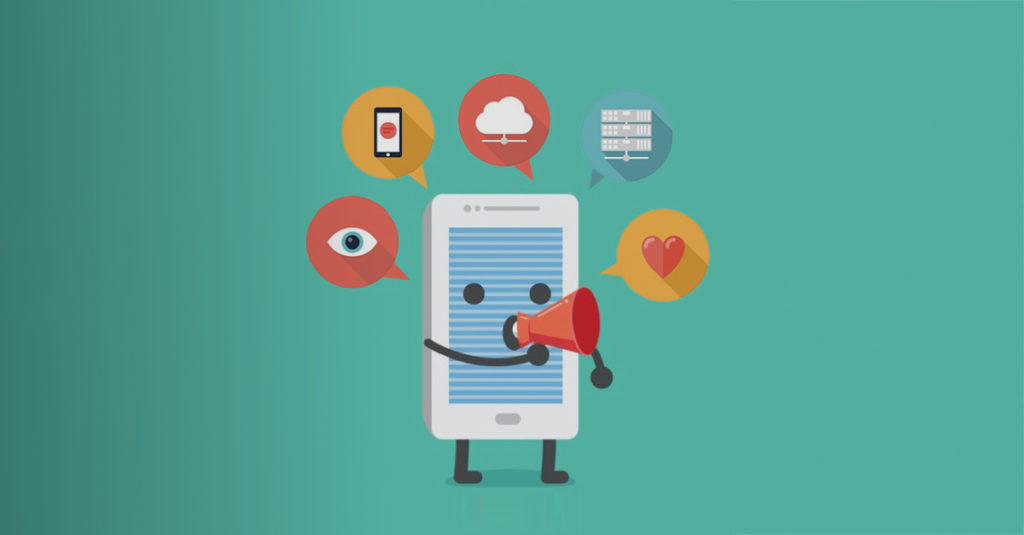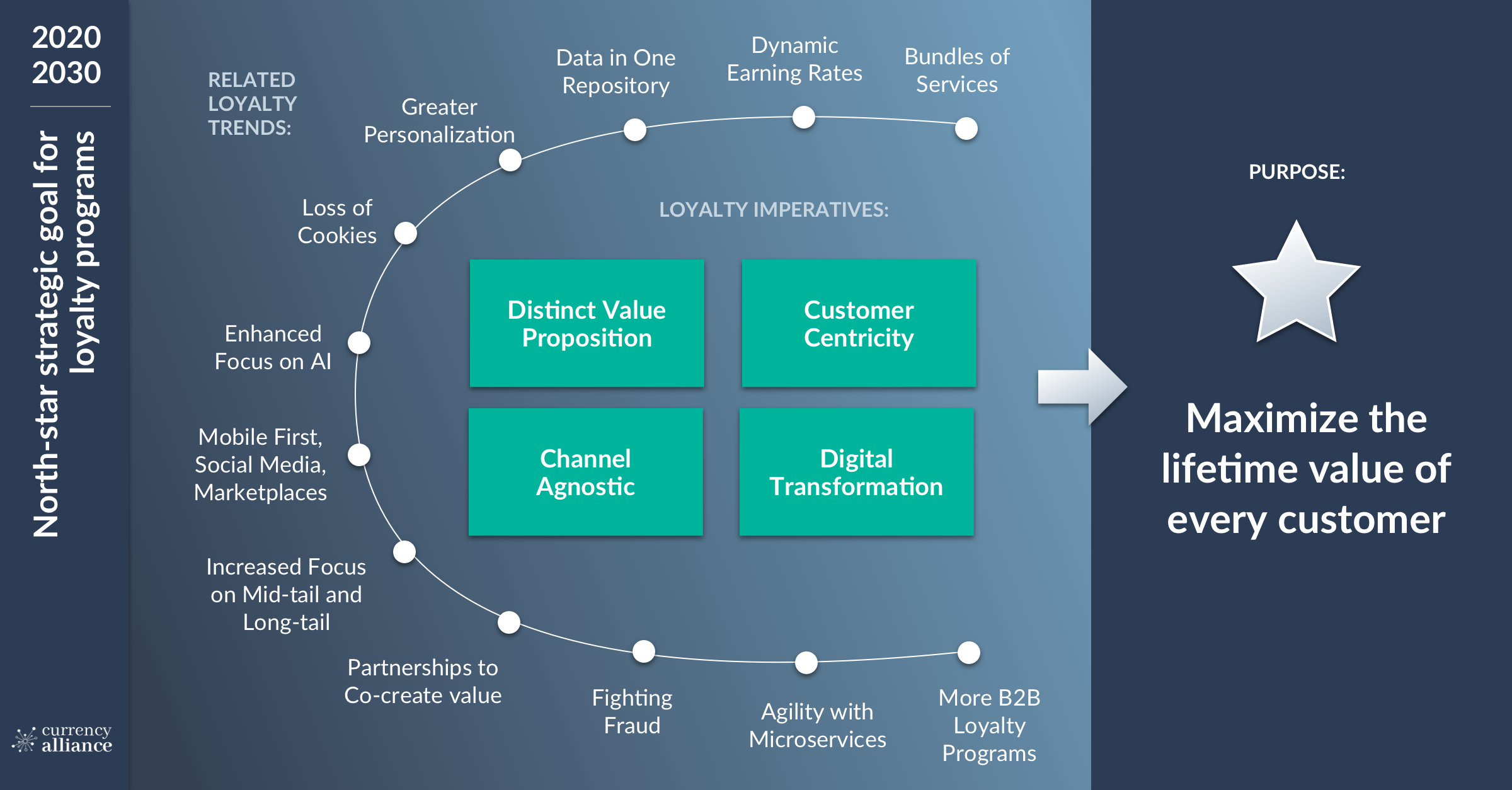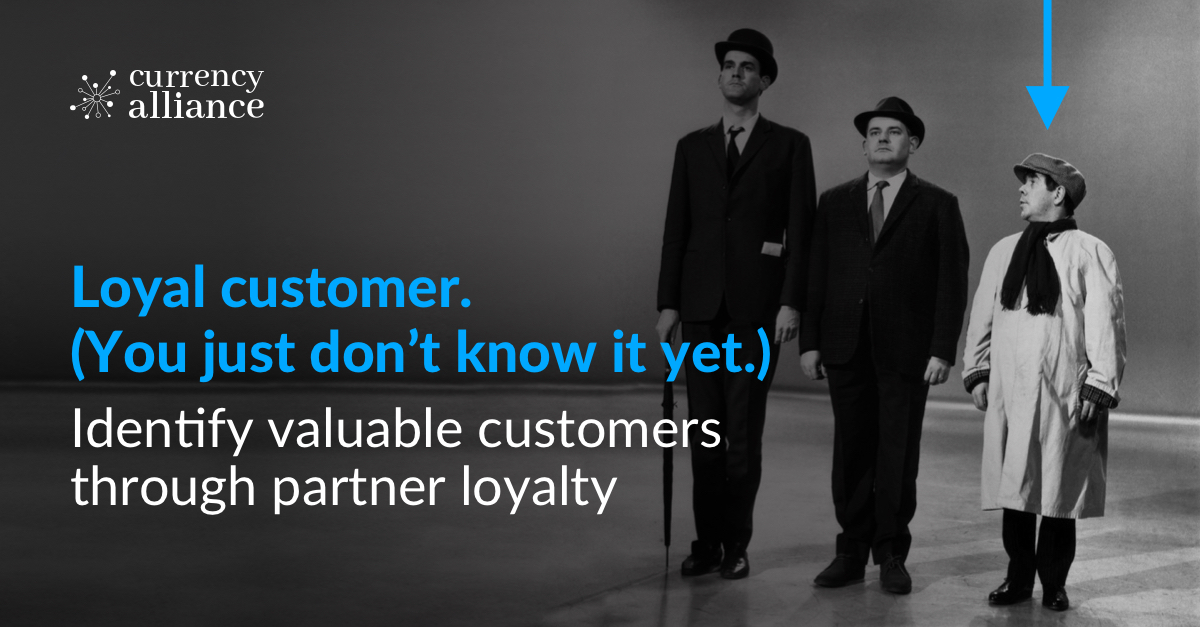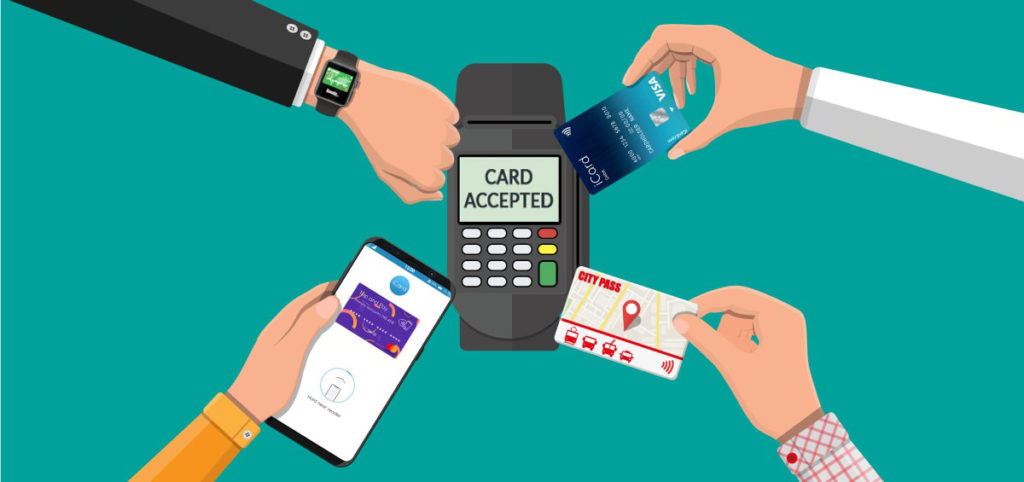Loyalty trends for 2022, and imperatives through 2030

Did you hear the term ‘Big Data’ during 2021 (or 2020 for that matter)?
I heard it once, two weeks ago at a loyalty conference in London. Loyalty trends were being discussed, as well as what had been hot topics in prior years – some of which just faded away as fads.
The conversation gave me pause to reflect on what exactly is a trend, how applicable are trends in Southeast Asia to brands in Europe, and whether embracing the hype around the latest trends could actually distract companies from a clear focus on their fundamental priorities.
So, I’ve decided it is of little practical use to tell a huge and diverse industry what trends will play out over the next 12 months. There certainly are important topics (trends maybe) that are getting a great deal of attention from loyalty marketers, and we will list them below, but knowing what is becoming popular in one part of the world, or in a specific industry, shouldn’t have much influence on what your company should focus on in 2022.
Most companies need to stay focused on what we call Loyalty Imperatives for this decade.
For instance: greater experimentation with artificial intelligence (AI) has been front and center for the past two years, but I’ve been hearing that term for 20+ years and still see only modest business impact at scale. AI is important, but still hard to harness – so it may still be years before anything truly significant is happening in loyalty with AI. I encourage you to keep experimenting because the constraint with AI is not the technology, but the lack of sufficient or clean data – two aspects covered by our Loyalty Imperatives.
In the context of your business, which trends are truly relevant to you depends on your industry, the dynamics of your market(s), your target customer segment(s), your geography, and your state of digital transformation. We can’t possibly write one article on what you should be doing, let alone summarize all the interesting things that other brands are doing in their unique context. Companies in some countries are still playing catch-up just to remain marginally relevant, while other companies are well ahead of the curve and delivering fantastic customer experiences and value.
This article defines the things that every business has to get right to survive. The pace at which you embrace them, and the specific way you achieve them, depends on your competitive environment, your culture, the technical architecture you have to work with, and your ambition.
But make no mistake; failing in the medium-to-long term on these Loyalty Imperatives will put your customer relationships at risk and ultimately damage your brand.
In order to understand why the four Loyalty Imperatives for this Decade are so important, let’s go back to the fundamental reason loyalty programs exist in the first place: to increasing the lifetime value of every customer. This includes lifting the value of frequent customers, capturing more share-of-wallet from less frequent customers, and engaging with new customers at low acquisition cost so your company can flourish.

Most programs do a fairly good job focusing on frequent customers. Your key question for 2022 should be:
“across each customer segment, how can I lower the cost of delivering the right mix of value to maximize ROI?”
The Loyalty Imperatives answer that question.
With that North Star in focus, we can now examine why the following four imperatives are so important:
- Distinct value proposition relates to your business strategy and how you want to create value with and for customers
- Customer centricity implies that you build solutions around customer needs
- Channel agnosticism ensures your brand is present where your customers are spending increasing amounts of their time
- Digital transformation enables the agility necessary to adapt to a constantly changing market
The combination of these four Loyalty Imperatives means that you can treat each customer as a person, understand what motivates them, and deliver personalized experiences that increase frequency, basket size, and affinity for your brand.
I encourage you to cut and paste this graphic onto a sheet of paper, mark where you think you are today on the scale of 1 to 10 and where you would like to be by the end of 2022.

On the right, you might indicate the importance as High, Medium, or Low for 2022. Then tape it to the wall near your desk so you are reminded every day of where to allocate your precious time and resources as next year unfolds.
Now, let’s talk about these imperatives, and the related initiatives that could be called trends, which all contribute to maximizing the lifetime value of every customer.
1. Ensure you have a distinct value proposition
Customers build affinity for brands that stand for something unique and help solve problems in their lives. Think of any popular brand and you should be able to identify 2-5 traits of that company that stand out – not only in your mind, but in the minds of its millions of fans.
These brands typically reinvent their value proposition in a proactive way every 7-10 years, rather than waiting until they are forced to change. That foresight to change when necessary is why they remain relevant and popular.
Now think of a few brands that are not particularly popular and try to define what they stand for. In most cases, they may not stand for much, but they have survived until now in a less competitive market where customers were less empowered with instant access to information. I doubt they will survive the rest of this decade.
Now think of the thousands of brands that have disappeared in the past 20 years. You can probably remember what many of them did, but I’ll bet you can’t define what they stood for, or whether they had any distinct value proposition.
We are not going to recite a business course on defining effective strategy in this article, but standing for something, organizing company resources to deliver a unique value proposition, and delivering consistently good experiences and high perceived value to customers, are all prerequisites for surviving in an increasingly competitive world.
Loyalty programs are no different. They must align the value proposition with the core business, but they must also be unique enough to stand out. Without a brand’s uniqueness, customers don’t really care where they shop.
The good news is your loyalty program is one of the most effective ways to achieve significant differentiation. In today’s world, comparable goods from competing brands are now of indistinguishable quality and price, while services are increasingly standardized and homogenized by pursuit of best practices. That forces brands to look elsewhere to create the truly differentiated value that drives true loyalty. If a company’s product or service is truly unique, they probably don’t have a loyalty program in the first place (think Apple, Accenture, Google, Tesla). If you have a loyalty program, it is because there are plenty of substitutes for what you sell.
Differentiation usually derives from intangible assets such as branding, or through your positioning on social issues and sustainability, as well as through special content provided customers. These things often work, but they are hard to measure.
With a loyalty strategy that builds upon all four Loyalty Imperatives, you stand a chance of attaining that all-important degree of differentiation, at lower direct cost, with greater recurring benefits.
That’s because these imperatives are made up of many tactical things done well; the combination of all four imperatives creates a flywheel where each one enables the others to improve more efficiently. The weighting brands give to the four different Loyalty Imperatives, and the speed at which they work towards them, allows so much room for uniqueness that there’s ample opportunity to differentiate from your competitors.
2. Strive for true customer-centricity
Covering trends such as emotional loyalty, greater freedom in redemption and zero party data
A decade ago, most companies organized themselves around product lines or services. This led to fragmented interactions with the same customer and often very different data collection or customer experiences. Banks are still struggling with this, as you often still need to get a loan from a different department than you might obtain a credit card or insurance.
Today, leading companies in each sector have migrated to a customer-centric approach where they organize service delivery around the customer and provide consistent experiences independent of what the customer is buying. This is necessary, because with instant access to information and low switching cost, the customer now absolutely has the power to dictate the terms of engagement with brands.
No matter where you are in your journey to be customer-centric, there is certainly more you can do.
Merging your loyalty and customer experience disciplines often breaks down walls that hinder delivering consistent customer experience. Given that customer touchpoints now take place across so many channels, getting data into a single repository in order to have a single, actionable view of the customer that can feed each channel continues to be a top priority.
As loyalty marketers learned many years ago, rewarding customers as fast as possible dramatically increases lifetime value; recent research shows that 86% of retailers offer some kind of reward within the first week of membership. This can entail offering more interesting, lower-cost alternatives for less frequent customers, but also incentivizing many other brand touchpoints to deepen the relationship. It will increasingly include allowing customers to earn your points with partners, to exchange between programs, or simply allowing them to earn the points/miles they really want.
We are seeing that a brand’s ego regarding its proprietary loyalty currency is diminishing as companies recognize that points are simply a cost of sale. Points are a powerful tool to influence customer behavior – if the points/miles perceived as valuable to the customer are offered in the first place. This implies that you collaborate with complementary brands to co-create value for common customers, and help each other lower the cost of customer acquisition and retention.
Brands should, therefore, let the customer decide how to use their loyalty value based on their own priorities and preferences. Of course, you can still control the value of your points depending on how the customer uses them, allowing you to retain the ability to influence behavior and control your operating costs.
Beyond putting the customer at the center of your business model, we are seeing a huge expansion of marketing initiatives targeting the mid-tail and longer-tail customer – who historically could not be bothered to join the loyalty program. The reason for this is that spending capacity among frequent customers is already maxed out, whereas many of your less frequent customers do spend considerably in your category, but spread their purchasing around. That makes less-frequent customers the biggest commercial opportunity because deploying the right incentives can quickly shift their spend to you.
GDPR and other data privacy legislation, as well as the pending loss of third-party cookies, also makes it important to offer less frequent customers good value so you have the right to stay engaged.
Loyalty programs are the legitimate excuse to get customers to opt into data processing, data sharing, and receiving direct marketing. If your loyalty program appeals to only 25% of your total customers, then you must find ways to appeal to 50-70% so you have the right and ability to influence a larger audience. With customers’ attention so fragmented, that opt-in is harder earned than ever.
The most precious commodity in most people’s lives is their time. A truly customer-centric loyalty ecosystem, which makes interacting with your brand quicker, easier and more interesting (rather than expecting customers to jump through hoops in order to benefit), leads to the best outcomes.
Helping customers save their precious time has such great value, that every company striving to improve customer engagement can probably still do more to smooth interactions. Even if you have optimized the most common interactions, extending this to less frequent use cases can really help you to differentiate your market positioning.
It is becoming clear worldwide that the best way to engage less frequent customers is by partnering with complementary brands in order to co-create more value for customers by sharing data, bundling offers, and enabling greater choice of rewards. In fact, at the Loyalty Summit conference in London last month, the common theme was how important partnerships had been during the past two years. Such collaboration often has a lower direct cost than cashback, discounting and other incentives, and it also enables greater customer frequency via the collaboration network of partners. It has the additional benefit of yielding shared insights which brands can use to enhance their own customer profiles to enable better personalization.
Deploying the right mix of incentives for less frequent customers, learning more about them, and making each relationship more valuable, is shifting share-of-wallet among these neglected segments. Those brands expanding segmentation from simple demographics to include psychographics, life-cycle stage, behavioral characteristics, and community/neighborhood/cultural involvement are lifting revenues based on better conversion due to improved personalization.
Another key component of customer centricity is how you collect and process customer data.
One of your top priorities must be to build rich customer profiles based on actual behavior with your brand, and to validate your beliefs about customer preferences by understanding how they engage with complementary brands. The result is better data, to feed analytics so that personalization can be improved with fewer risks.
When you provide points/miles only for purchases, you tend to capture data only about the products a customer buys from you. Emotional loyalty has been discussed as a trend for the past three years, but few brands have started incentivizing non-purchase touchpoints with their customers. This means they are not encouraging customers to take the next step along the desired journey to a purchase, let alone building habits that lead to increased sales over time.
The reason such non-purchase touchpoints are so important is that they can yield the qualitative ‘zero-party’ data (as well as more first-party data) which has become essential for building customer profiles, particularly as cookies and other third-party data becomes difficult to obtain, or as your right to use it diminishes.
Incentivizing engagement on social media, in third-party platforms, via the call center, or at other non-transactional touchpoints, can help you understand potential causes of churn, throw light on specific stages in the sales cycle, and provide clues as to what information the customer needs next to develop a preference for your products/services. That can help you calculate what additional level of incentives is required to get the purchase and start building habits that favor your brand.
Customers have always appreciated being recognized. As some brands are doing a good job of recognizing customers and treating them in a special way across channels, the customer’s expectations are growing for how they would like to be treated by every brand. Your ability to deliver will ultimately depend on the profiles you are building. Data from partners accelerates profile building and can greatly improve profile accuracy, so you can recognize each customer for who they are.
Customer recognition in the form of tier status gained momentum in 2021, so we should see more of this stratification of customer segments in 2022 – not only to drive frequency, but to provide a clearer ladder for those less frequent customers who can be persuaded to shift share of wallet.
Get these things wrong about profiles and building enduring relationships, and no amount of points will create a loyal customer base.
3. Strive to be channel agnostic
Covering trends such as mobile apps and marketplaces
Delivering convenience improves both the customer’s experience and their perception of value. As we have said for years, offering loyalty points can cover up blemishes in how customers are served, but a customer’s real loyalty comes from their overall perception of value and their cumulative experience with a brand.
So: does your company make it equally easy to buy your products or services on your own websites/apps, on partner platforms, via marketplaces, through a call center, or any other channel where your target customers spend an increasing percentage of their time?
Do you reward customers with points only when they make purchases on your website(s)/app(s), or can they also earn points when buying your products or services via partners or in social media? In recent research by Deloitte, 21% of customers had purchased products from brands on social media. This will grow.
Do you incentivize non-purchase touchpoints to influence the customer’s journey and to guide them to a point where they eventually make a purchase?
Customer preferences for mobile access to a brand’s information, services, or products started long before the Covid-19 pandemic, but the past 20 months have certainly accelerated the need to provide customers with easier ways to engage in business.
Innovation by retailers during the past 20 months has also ramped up customers’ expectations. These have been high for quite some time, since the best experience received from any brand quickly becomes a customer’s expectation of every brand. But now, consumers are more likely to demand that their favorite brands serve not only a functional need, but also a symbolic one in aligning with their beliefs and values.
The environment, and how brands deal with environmental issues is now influencing a significant minority and will soon be the majority of customers. This trend will grow in importance this decade, and brands that are not transparent about their commitment to reducing their carbon footprint will lose favor.
Starting before Covid-19, customers increasingly became concerned about how their data was collected, used, and stored. Brands with data breaches have suffered significant customer churn, so publishing clear data usage policies and providing tight security controls are increasingly important. During the pandemic, other values also became important – such as how employees were treated.
Personalization has as much to do with how you provide offers and rewards that align with values, as it does with getting the right message delivered through the optimal channel based on the context of the customer at the moment in time when they receive it. This is tricky even for the best technology.
Like the other Loyalty Imperatives, improving the customer experience has been an ongoing priority for a decade and we anticipate for many brands this will continue well into the future. Most brands now deliver a good experience in their controlled channels, and now need to extend their footprint to non-controlled channels like third-party marketplaces and on social media. A channel-agnostic loyalty ecosystem can have significant impact in delivering consistent experiences and customer recognition beyond touchpoints controlled by your company.
The ability to burn points for carbon offsets on flights is now a common appearance, but brands can go further. Some CPG brands have started adding QR codes to their packaging so that customers can learn about the sustainability of the products. In an optimal setup, the customer would scan that code using their loyalty app so that they could be immediately identified and their interest in sustainability used to personalize further engagement. The mobile device itself can provide many clues about the customer’s current context, needs, and the applicable use-cases necessary to facilitate an optimal journey to each stakeholder’s desired outcome.
Media channels, meanwhile – such as your company blog, or the channels of third parties – are also key components of the customer experience, and channels which could become loyalty-enabled. In your own media channels, building in loyalty mechanics using API-first loyalty software should be fairly simple. But in environments which you don’t control, you need partnerships in place so that the partner has an incentive to present your brand prominently, and in the most favorable light.
This can also help to build a narrative around bundled services offered in collaboration with your partners, and potentially help to entice opt-ins and subscriptions.
You can’t catch fish if you don’t have your hook in the water. Many brands historically did well in their local pond. Now, the internet has turned the marketplace into an enormous ocean, and you need to have lots of hooks in the water. That implies using partnerships to be present where your customers are.
4. Push forward with digital transformation
Covering trends such as AI, loyalty fraud, and loyalty microservices
Given the pace of change in…
- customer expectations
- lowering cost of available technologies
- competitive pressure
- government regulations
- collaboration with third parties
- B2B loyalty
- …and internationalization
… a business’ supporting architecture must now be modular, rather than monolithic. This allows teams to be more agile and independent in adapting to threats and opportunities.
For years, brands have been migrating off monolithic legacy platforms and deploying services across all the channels through which customers engage – but this has certainly been gaining pace in 2021 and it will continue well into the future. You should be planning for constant technical upgrades and constant adoption of new tools.
For a few years, applications constructed of microservices have been a hot topic. While their definition is beyond the scope of this article (read about loyalty microservices here), a technical architecture incorporating microservices allows companies to add functionality, swap out technologies, upgrade their customer-facing platforms, and simplify implementation – all while minimizing impact on interdependent applications.
In loyalty, most systems continue to be monolithic stacks of software that bundle together the…
- points bank
- rules engine
- CRM
- campaign management
- the redemption catalog
- …and the customer-facing platforms.
Even if these systems now run in the cloud on virtual servers, the modules can still be difficult to modify if tightly bundled together. Microservice solutions allow a dedicated points bank and/or loyalty rules engine to work seamlessly with existing enterprise CRM and campaign management systems. Microservices for commerce can enable the replacement of static redemption catalogs and allow your customers to find attractive rewards in a more interesting redemption ecosystem.
As a technology service provider, I often hear the phrase, ‘but our system won’t allow that.’ Perhaps that excuse works on vendors, but customers don’t care about your technical constraints. They will just switch to someone who can satisfy their needs.
A loyalty program constrained by technology must change systems, or put an agile technology in front of their legacy system in order to keep up with change this decade.
A microservices architecture can also make it easier to fight fraud, which is becoming a much higher priority. It can allow you to add algorithms and third-party fraud monitoring and prevention services quickly and easily. Access to loyalty programs, customer data, and their points is often much easier for fraudsters than getting access to other systems. And as brands enable greater freedom for customers in how they can spend their points or enable instant gratification, they enable the same freedoms for criminals.
But like most loyalty trends that are really longer-term imperatives, fighting fraud will go on indefinitely – so the capabilities to fight it off are an ongoing imperative, not a one-time project (or trend) for 2022. Given that fraudsters are quite innovative, a microservices architecture will give you the ability to adapt quickly to new threats and increase your chances of keeping one step ahead.
Tools like AI will deliver more capabilities at ever-reducing cost. To benefit from them, brands must continue getting their data into an environment where it is actionable, and importantly where they have all the right data (and not too much extra data) to understand customers’ lifestyle preferences and enable personalization.
Most organizations collect far more data than they need; most of it is noise. Every few years, brands should reevaluate which insights about customers drive the highest levels of engagement, to make sure they keep in step as the market evolves. Importantly, understanding these insights allows you to identify where to obtain incremental data that unveils the real lifestyle interests of your customers.
In many cases, that data won’t come from your own systems. It could come from partner brands that also serve your customers.
Start working toward the 4 Loyalty Imperatives today
So, you can see how inter-related these four Loyalty Imperatives are, and hopefully how progressing on each one makes the others a bit easier as your company takes steps into the future.
Many people I speak with understand the importance of these Loyalty Imperatives and seem to be making good progress. The going can be hard, but the important thing is to keep making progress.
The number of requests for proposal (RFPs) for new loyalty technology hit an all-time high in 2021 and this is likely to continue in 2022 as brands upgrade their martech stack to meet the demands of the evolving marketplace.
We haven’t seen a lot of flashy new loyalty programs or campaigns in 2021, but there is a huge amount of work and investment going into the backend systems that power loyalty in order to improve agility. We should see some interesting innovations coming to market in 2022 and 2023. In fact, I believe some of them will be surprising; not only by the program design, but by the brands getting into loyalty marketing. Some of you may end up with competitors you never expected.
All the activity cited in this article can be addressed on a continuum over many years – depending on where your evolution is today. The goal must be constant evolution toward your primary purpose: to increase the lifetime value of every customer.
As mentioned above, gaining the operational agility to innovate in your loyalty program is made possible by having the tools for the job. Today, that does not mean spending months or years building the right solutions, but using smart technology to quickly enable your business to drive maximum customer engagement in an agile environment.
With the right modular architecture in place, business teams can greatly reduce their dependence on the IT department or vendors – setting up and executing campaigns via management portals with a few clicks of the mouse. The direct and indirect cost savings can be tremendous, while your agility to respond to market opportunities creates the speed to win.
Currency Alliance was founded to give brands that level of agility.
For brands pushing forward with their digital transformations, our lightweight SaaS loyalty tools are available as a thin layer of cloud-based services which enhance your existing technology, allowing you to quickly meet customers’ expectations without ripping out existing systems.
For brands prioritizing customer centricity and channel agnosticism, our platform is designed for quick and easy API integration with any of your existing martech. With our Points Bank and Rules Engine, you can upgrade your loyalty solution and leverage your investment in enterprise CRM and campaign management software, without acquiring redundant (and expensive) loyalty solutions that have these components deeply embedded in them. Most of our clients have gone live in a matter of days or weeks with no CapEx, so speed to value is really quick.
And for brands striving for truly differentiated customer value, the easiest way to achieve that is to find and connect with new partners in our Global Loyalty Marketplace: a B2B environment, where brands can explore potential loyalty partners, and start doing business together quickly – at very little cost.
Explore Currency Alliance’s loyalty marketplace here.




